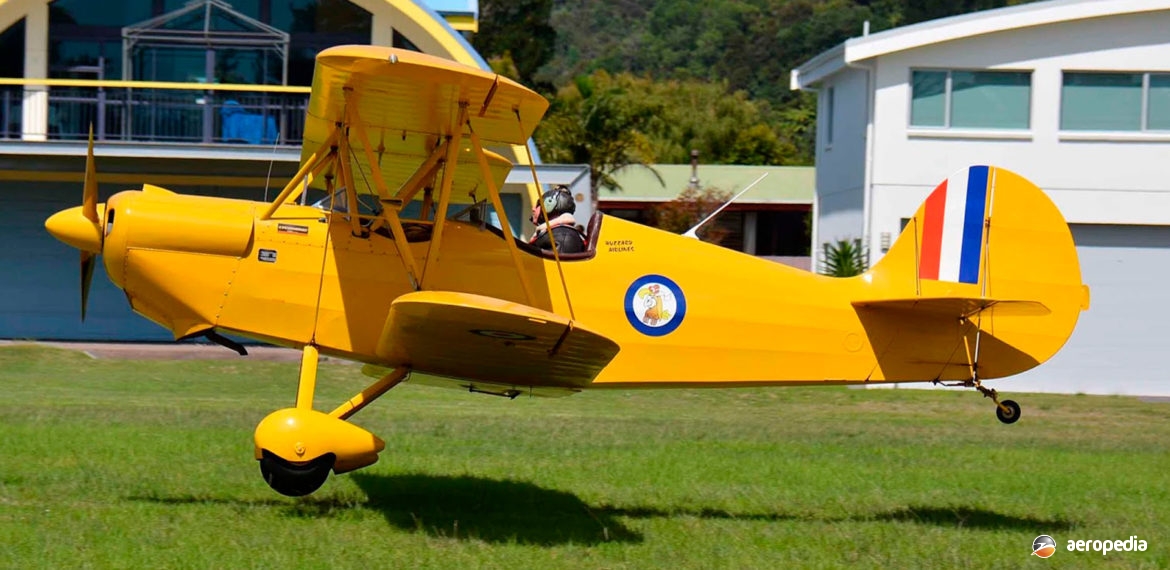Photograph:
Hatz CB-1 ZK-PEC (c/ 245) at Paunaui, New Zealand (Richard Currie – NZCIVAIR)
Country of origin:
United States of America
Description:
Two-seat light sport biplane
Power Plant:
One 75 kw (100 hp) Continental O-200 four-cylinder horizontally-opposed air-cooled engine
Specifications:
- Wingspan: 7.71 m (25 ft 4 in)
- Length: 5.79 m (19 ft 2 in)
- Height: 2.4 m (7 ft 10 in)
- Wing area: 16.53 m² (178 sq ft)
- Max speed: 169 km/h (105 mph)
- Cruising speed: 137 km/h (85 mph)
- Stalling speed: 61 km/h (38 mph)
- Rate of climb: 213 m/min (700 ft/min)
- Range with 20 mins reserve: 463 km (288 miles)
- Landing run: 183 m (600 ft)
- Fuel capacity: 79 litres (17.4 Imp gals)
- Empty weight: 386 kg (850 lb)
- Useful load: 249 kg (550 lb)
- Loaded weight: 635 kg (1,400 lb)
History:
The Hatz CB-1 was a two-seat light aerobatic biplane produced in kit form for the American Hatz Association of Gurnea, Illinois. It was designed by Mr John D Hatz of Gleeson, Wisconsin, in September 1959 to provide the amateur constructor with an aircraft which was simple to build but of good performance with good slow flight characteristics.
The type comprised a welded steel tube fuselage with wooden wings, all fabric covered. More than 150 examples have been delivered around the world and a couple was imported to Australia in 2003. Power plants in the 75 kw (100 hp) to 112 kw (150 hp) range have been installed, usually from the Continental or Lycoming ranges, although engines as low as 63 kw (85 hp) have been installed. Design parameters were +5G/-3G, and fuel capacity was 68 litres (15 Imp gals) in standard form.
The CB-1 received certification in the Experimental (amateur-built) category in the United States of America on 18 April 1968 and the prototype made its first flight on 19 April powered by a 63 kw (85 hp) Continental C85-12 engine, this later being replaced by a Lycoming O-320 engine. Plans were initially made available to constructors by Merrill Airways of Merrill, Wisconsin.
A few examples have been built in this region, registered in Australia under Recreational Aviation Australia (RAA) Regulations. Eventually the aircraft was marketed under the name of Makelan Corporation.
One example registered in New Zealand was a CB-2 which became ZK-PEC (c/n 245) on 29 November 2004, painted in the markings of Buzzard Airlines and based at Tauranga.
Development of the design by various builders has taken place over the years. Variants have included the CB-1,the original basic biplane, and the Hatz Classic designed by William Dawson which had a more rounded fuselage to make it look like a 1930s type which was fitted with a nine-cylinder Australian-built Rotec radial engine. The Kelly D variant was designed by Dudley Kelly and was a simplification of the original design; and the Hatz Bantam was a variant designed to meet American Light Sport Aircraft (LSA) Regulations. Another variant has been the Hatz CB-1 (MS) which was fitted with a 108 kw (145 hp) Warner seven-cylinder radial engine.

